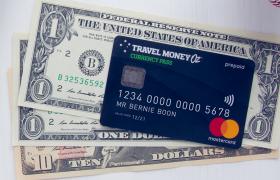TGIF everyone. As much as we want you to be travelling, we also hope you haven’t got a trip booked straight away, as the poor old Aussie dollar isn’t doing too well. The Coronavirus continues to have a dampening effect on the value of the AUD, which was further depleted after an unexpected rise in the unemployment rate this week. The combined impact of this and the struggling Aussie economy has decreased the value of the AUD by 6% since the start of the year. With this in mind, today one AUD will buy you:
0.6443 US dollar
71.236 Japanese yen
0.5888 Euros
0.4944 Great British pound
0.8229 Canadian dollars
1.0103 New Zealand dollars
0.8729 Singapore dollars
If you are travelling soon and need to buy currency, fear not! Simply add Rate Move Guarantee to your purchase in-store, and if the rate improves within 14 days we will refund you the difference!*
Let’s take a deeper dive into what’s going on with the AUD
USD is rock solid
The USD is a force to be reckoned with at the moment and increased against most major currencies overnight after a good run of positive economic data. In particular, the Philadelphia business survey for February surged to its highest level in three years. This is the first of the monthly regional surveys to be released, and if the others imitate Philly’s surge, it could very well lead to further gains in the value of the USD.
Coronavirus: an ongoing saga
The Coronavirus continues to spread across China and the world. This week Japan saw a spike in cases, with the number of infected doubling to 84. Virus concerns are putting downward pressure on the already weak Japanese economy, which is, in turn, causing weakness in the Japanese yen. Great for Aussie travellers taking advantage of the ripper Japan travel deals at the moment, bad for the Japanese economy.
With no real signs that the virus is slowing, ScoMo has extended the travel ban on Chinese residents entering Australia by another week. While this was done with the health of Australians in mind, it, unfortunately, coincides with the start of the university semester and prevents almost 100,000 international students from entering the country. The longer the delay, the more significant the impact on the AUD as we lose out on Chinese students and tourists injecting money into the economy.
As you can imagine, the Chinese economy is taking the biggest hit from the virus. Unfortunately, our trade ties to China mean the weakness in the Chinese yuan weighs further on the value of the AUD. Today the Commonwealth Bank will release purchasing managers index (PMI) data for February, which will hopefully provide an insight into the early economic effects of the virus on the Australian economy.
Domestic Data Disappoints
This week the unemployment rate for January was released. Unfortunately, it rose from 5.1% in December to 5.3%, despite a reasonable lift in full-time jobs. To put things into perspective, the Reserve Bank of Australia ideally wants an unemployment rate below 4.5%, as this will allow wage growth to pick up and increase domestic spending. More spending helps the economy speed up and will, in turn, put upward pressure on the value of the AUD – something we can all agree is needed right now.
Before unemployment figures were released, markets were pricing an April interest rate cut at 22%. This has now increased to 34%. Markets now expect an interest rate cut in both April and August, meaning we will close out 2020 with interest rates at 0.25%. Cuts are no-good, dirty rotten news for the value of the AUD, as investors will move elsewhere seeking a higher return.
The only thing that stopped the AUD from completely bottoming out this week was an increase in Iron Ore prices to $US93.50 per ton. A small, but much-needed win for our little Aussie battler in a time of need.
Fingers crossed we come with better news next week. Until then, keep an eye on the news and join the Travel Money Club so you can be up to date with what is happening in the big bad world of currency markets.














